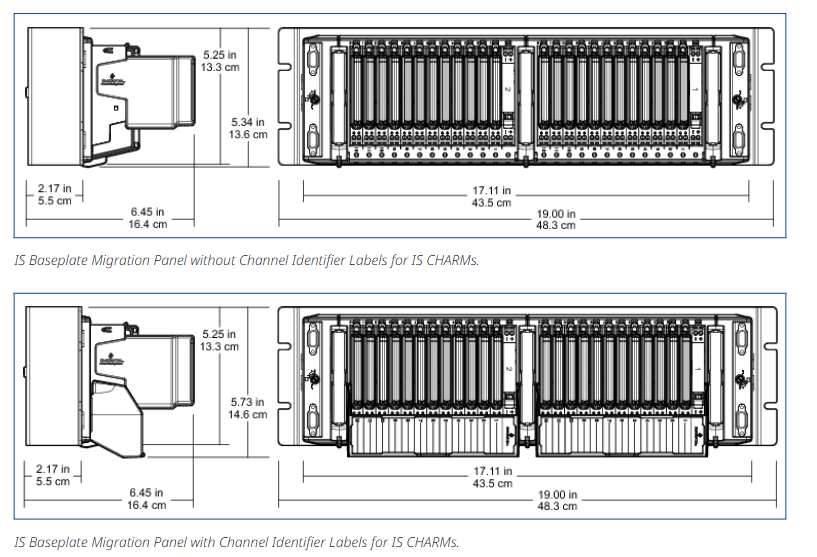Emerson DeltaV Electronic Marshalling Migration Solution
Digital output (DO): 24Vdc (maximum 0.5A/channel), relay output (250Vac/5A).
Communication protocol: EtherNet/IP protocol is used between the electronic grouping cabinet and the controller, supporting high-speed data transmission (communication rate 100Mbps full duplex); The module adopts DeltaV dedicated backplane bus internally.
Power requirements: The power supply for the electronic grouping cabinet is 24Vdc (± 10%), and the maximum power consumption of a single cabinet depends on the number of modules (typical value: power consumption of each CHAR module ≤ 5W).
Environmental conditions:
Working temperature: 0 ℃~55 ℃ (cabinet environment);
Storage temperature: -40 ℃~70 ℃;
Relative humidity: 5%~95% (without condensation);
Anti electromagnetic interference: Complies with EN 61000-6-2 (industrial environment immunity) standard.
Security certification:
Electrical safety: UL 61010-1, CSA C22.2 No. 61010-1;
Electromagnetic compatibility (EMC): EN 61326-1 (industrial environment);
Hazardous area certification (some components): ATEX, IECEx (applicable to Zone 2/Class I, Div 2).

Migration process and applicable scenarios
1. Standard migration process
The DeltaV electronic grouping migration follows a "four stage" implementation framework to ensure parallel operation and smooth switching with the old system:
Planning and Evaluation Stage
Evaluate the I/O signal types, quantities, cable routing, and control logic of old systems such as RS3 and WDPF;
Determine the number and installation location of electronic grouping cabinets (usually near old terminal cabinets to reduce cable modifications);
Develop a migration schedule (distinguishing between "non critical circuits" and "critical circuits", prioritizing the migration of non critical circuits).
Installation and configuration phase
Install electronic grouping cabinets, CHAR modules, and on-site wiring terminal boxes (if necessary) while the old system is running normally;
Connect the on-site cable to the CHAR module (without disconnecting the old system wiring, dual system signal acquisition can be achieved through "T-shaped wiring" or parallel wiring);
Configure signal routing in DeltaV software (mapping CHAR module channels to DeltaV controller I/O points) and import old system control logic (supporting logic conversion tools).
Testing and Verification Phase
Conduct offline testing on the migrated circuit (simulate on-site signals to verify the correctness of control logic);
Conduct online parallel testing (both the old and new systems receive on-site signals simultaneously, compare the output results, and ensure consistency);
Perform multiple rounds of validation on critical circuits such as emergency shutdown system ESD and reactor temperature control to ensure no deviation.
Switching and optimization phase
Select non peak production hours to "switch" a single circuit or area (disconnect the old system wiring and be controlled separately by the new system);
Continuously monitor the operating status of the system after switching, and use DeltaV diagnostic function to identify potential faults;
After completing the full system migration, dismantle the old system hardware and optimize the new system parameters (such as control algorithms and alarm thresholds).
2. Applicable migration scenarios
This solution is not applicable to all DCS migrations, and the core matches the following scenarios:
The old system is a hard wired DCS, such as Fisher Rosemount RS3, Westinghouse WDPF, Honeywell TDC 3000 and other old systems without flexible I/O architecture;
Industries with high downtime costs, such as refining, ethylene, LNG, and other continuous production processes, can experience significant economic losses due to long downtime caused by traditional migration;
The on-site equipment is in good condition: the on-site sensors and actuators are still within their service life and do not need to be replaced (if the equipment has aged, it can be implemented synchronously with "equipment update+electronic grouping migration");
Limited space in the control room: The electronic grouping cabinet has a smaller volume and is suitable for scenarios where there is insufficient expansion space in the control room.
Not applicable scenario: The old system is a fully digital architecture (such as systems that have already adopted Profinet and Foundation Fieldbus); All on-site equipment needs to be replaced (it is more economical to directly use the new DeltaV system at this time).

System advantages and competitive differences
1. Core advantages (vs traditional migration)
Comparison Dimension DeltaV Electronic Grouping Migration Traditional Hardwired Migration
Short downtime (hourly level, only shutdown during switching stages) Long downtime (several days/weeks, complete system dismantling and reconstruction)
Low wiring cost (no need to re lay on-site cables, only need to connect between cabinets) High (all on-site cables need to be replaced, especially long-distance circuits)
High flexibility (software configuration signal routing, no wiring required for subsequent changes) Low flexibility (fixed hardware wiring, rewiring required for changes)
- EMERSON
- Honeywell
- CTI
- Rolls-Royce
- General Electric
- Woodward
- Yaskawa
- xYCOM
- Motorola
- Siemens
- Rockwell
- ABB
- B&R
- HIMA
- Construction site
- electricity
- Automobile market
- PLC
- DCS
- Motor drivers
- VSD
- Implications
- cement
- CO2
- CEM
- methane
- Artificial intelligence
- Titanic
- Solar energy
- Hydrogen fuel cell
- Hydrogen and fuel cells
- Hydrogen and oxygen fuel cells
- tyre
- Chemical fiber
- dynamo
- corpuscle
- Pulp and paper
- printing
- fossil
- FANUC
- Food and beverage
- Life science
- Sewage treatment
- Personal care
- electricity
- boats
- infrastructure
- Automobile industry
- metallurgy
- Nuclear power generation
- Geothermal power generation
- Water and wastewater
- Infrastructure construction
- Mine hazard
- steel
- papermaking
- Natural gas industry
- Infrastructure construction
- Power and energy
- Rubber and plastic
- Renewable energy
- pharmacy
- mining
- Plastic industry
- Schneider
- Kongsberg
- NI
- Wind energy
- International petroleum
- International new energy network
- gas
- WATLOW
- ProSoft
- SEW
- wind
- ADVANCED
- Reliance
- YOKOGAWA
- TRICONEX
- FOXBORO
- METSO
- MAN
- Advantest
- ADVANCED
- ALSTOM
- Control Wave
- AB
- AMAT
- STUDER
- KONGSBERG
- MOTOROLA
- DANAHER MOTION
- Bently
- Galil
- EATON
- MOLEX
- Triconex
- DEIF
- B&W
- ZYGO
- Aerotech
- DANFOSS
- KOLLMORGEN
- Beijer
- Endress+Hauser
- MOOG
- KB
- Moxa
- Rexroth


Email:wang@kongjiangauto.com
























































































































